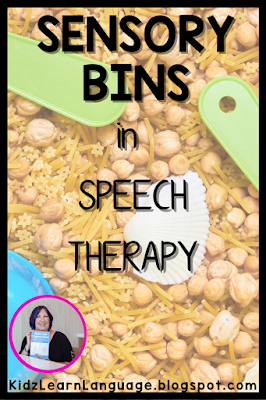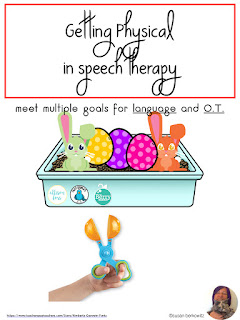Recently, sensory bins are a big “thing” in speech therapy and a big hit with students. While I never used sensory bins in therapy (my last therapy gig was more than 20 years ago), I can see why kids would like the process of “digging for buried treasure.”
Two of my favorite goals to target involve increasing students’ abilities to describe and increasing their ability to tell a story. So I thought I’d make a few suggestions for using sensory bins with your students with limited language - or AAC users who are developing language skills.
First, for those of you unacquainted with sensory bins, these are containers of almost any sort (shoe boxes, plastic tubs, big baskets) filled with any of a variety of filler materials - beans, cotton balls, raw pasta shapes, rice, sand. (Warning: that last one can get messier than the others).
Students “dig” through the filler to find the treasures; which can be laminated pictures, small figures, or other objects related to your topic or theme.
I’ve suggested using sensory bins with books to colleagues. You know me; gotta get that literacy tie-in everywhere I go!
Choose a story to work with. Copy the illustrations of people, animals, even places (it is legal to make a copy of a book you own for a student who has difficulty accessing print) and laminate them. Cut out the figures and bury them in the filler.
You can also purchase small plastic figures in thematic sets. If you happen to own Playmobile or Lego figures that are pirates, animals, superheroes, etc. that’s terrific. But they can be expensive to purchase for all your sensory bins.
Next, set your target. If you’re working just on describing and defining, You might have a random collection of items to hunt for. Or you might stick to a single category with a variety of members.
If you’re working more on narratives, you might choose items that represent characters and objects in a specific story.
Then set the parameters for the ‘treasure hunt’ itself. You can have students find items randomly and describe whatever they’ve found. This is great for having AAC users practice using the core words on their describing page.
Or, you can have students choose one figure at a time and build a round-robin story. The first student begins the story by saying something around what he has chosen from the bin. The next student builds on the story, and so on. AAC users can get lots of practice with people and actions pages of their system.
Or, you might hide story elements from a single story, and have students identify the element and describe it or tell about its place in the story. You can also have students pick items from the bin and re-tell the story once everyone has a piece.
There are many ways you can use these sensory bins in therapy to make building language more fun for your students.
Have students who have a hard time grasping small items? Try these, from Amazon:
Looking for more ideas for implementing AAC in therapy and at home? Try my book; Make the Connection!: A Practical Guide to Parents and Practitioners for Teaching the Nonverbal Child to Communicate with AAC.




Nice post.
ReplyDeleteenetget.com